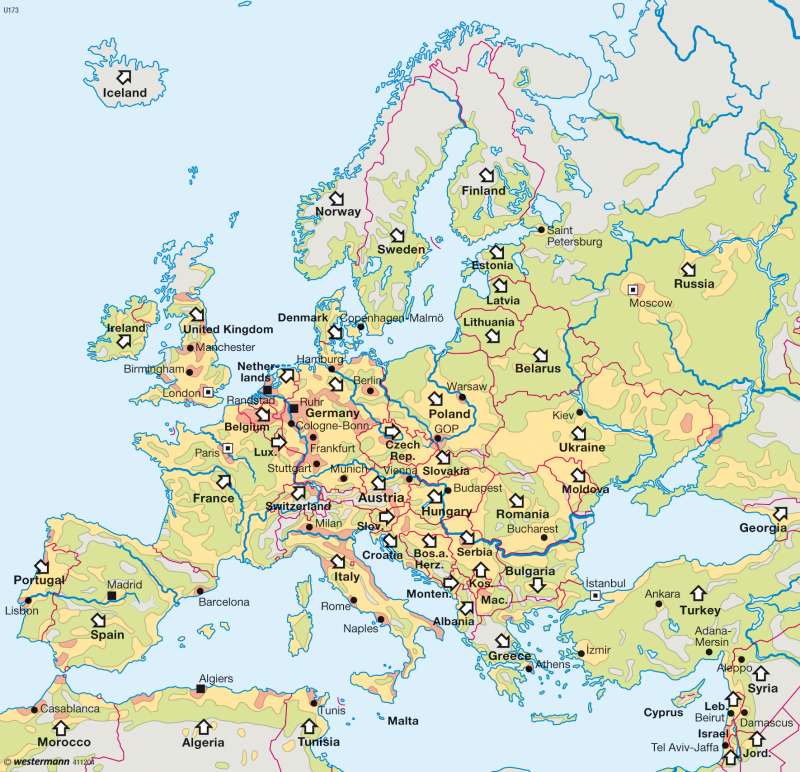Population
Europe - Population
978-3-14-100790-9 | Page 42 | Ill. 2

Information
The rate of population in Europe is quite low. Only Ireland, Iceland, Luxembourg, Cyprus and Turkey recorded population growth of more than one percent from 1990 to 2005, whereas growth trends in many countries in South-western, Eastern and Central Europe were negative. Generally speaking, the populations of nearly all European countries are ageing as life expectancy rises and birth rates as well as average numbers of children per family decline.Distribution patterns
The map shows the unequal distribution of the European population. The only regions on the continent in which population density falls below ten inhabitants per square kilometre are located in northern Russia and Scandinavia, in Iceland and at the highest elevations in the Alps and the Pyrenees. Temperature and elevation boundaries are limiting factors in these regions. The elevation boundary is significantly lower towards the North Pole than in the Alps, where only the highest areas, such as the Tauern Range and the Bern Uplands have less than one inhabitant per square kilometre. Although numerous alpine farmers have left these regions for economic reasons in a veritable "exodus from the heights", the trend has been largely offset by a rise in tourism.
One particularly striking phenomenon is the relative population density on the coastal fringes of many countries, particularly in Italy, Spain and Portugal and along the Black Sea and North Sea coasts. Denser belts of settlement are also found along a number of rivers, which, like the coastal areas, typically offer favourable conditions for agriculture.
Despite the presence of these patterns, population distribution is not influenced by natural factors alone, as is evidenced by what is perhaps the most remarkable feature on the map, namely the belt of highest population density that extends from Great Britain to northern Italy and encompasses roughly two-thirds of the population of the EU within its rather vaguely defined boundaries. The largest share of European industry is concentrated along this economically dynamic European axis, which is not a homogeneous structure but consists instead of a series of urban and metropolitan agglomerations. In terms of employment structure and economic productivity, however, the importance of industry has waned in comparison to that of the service sector since the end of the 20th century. More significant today is the fact that the political decision-making centres, including such cities as Brussels, and the major banking and financial service hubs, such as London, the Rhine-Main region and Zürich, are concentrated within this densely populated band. The central significance of urban agglomerations around national capitals (Paris, Madrid) is particularly evident in large, less densely settled regions such as those in the interior of France and Spain.
Migration
Densely populated regions such as those found along the main axis of concentration from Great Britain to northern Italy are the product of urbanization in highly industrialized, service-oriented nations. These urban agglomerations and densely settled regions are by no means all areas of dynamic economic activity, despite the infrastructural advantages they offer in many cases. Industrial areas such as the Ruhr region, which flourished as centres of the mining industry, recorded a negative migration balance as a result of the coal and steel crisis. Several densely populated areas in the new German states also suffered migration losses after 1990. It is important to note, however, that, particularly in the mining regions. structural change from an economy dominated by heavy industry (mining and processing) to one characterized by light industry and services has been accomplished with great success in many cases, especially where the waning importance of heavy industry has not been compounded by a transformation of the economic system.
Migration losses in areas once characterized by mass emigration, especially peripheral rural regions, have decreased in part and have actually come to a stop in some cases. However, there is currently no sign of a reversal of the process of population concentration in the sense of a "counter-urbanization" movement in Europe. Zones of concentration have proven remarkable consistent. Attractive metropolitan areas such as Munich have positive migration balances. Naturally, however, the status and significance of individual conurbations are subject to frequent shifting and flux.
W. Storkebaum; U: Southard




